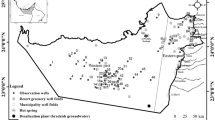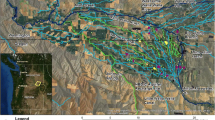Abstract
Water supply reliability in Southern California is facing serious problems because of reduction in the availability of water from the State Water Project and Colorado River, drought, and growing concerns about environmental restoration. Groundwater sources supply more than fifty-five percent of domestic demands in the Western Riverside County. Western Municipal Water District is planning to increase water supply reliability by expanding the Arlington Desalter production which requires additional groundwater pumping from the Arlington Basin. Western was concerned that increasing groundwater pumping will cause excessive decline in groundwater levels, leading to decreased yields at existing Desalter wells. Three-dimensional groundwater flow model was developed for the Arlington Basin to investigate different water management strategies. Five groundwater management scenarios were run for a 30-year time period. The five model runs were used to determine the feasibility of the Arlington aquifer system to supply groundwater to the Arlington Desalter over the 30-year life of the facility. Model simulation results showed that long-term groundwater pumping from the existing Desalter wells is not sustainable without artificial recharge. However two of the modeling scenarios which incorporated a combination of artificial recharge and new production wells, were shown to meet the increased Desalter yield requirements as well as minimize adverse impacts.















Similar content being viewed by others
References
California Regional Water Quality Control Board, CRWQCB, Santa Ana Region (2004) Resolution No. R8-2004-0001—Resolution Amending the Water Quality Control Plan for the Santa Ana River Basin to Incorporate an Updated Total Dissolved Solids (TDS) and Nitrogen Management Plan for the Santa Ana Region Including Revised Groundwater Subbasin Boundaries, Revised TDS and Nitrate-Nitrogen Quality Objectives for Groundwater, Revised TDS and Nitrogen Wasteload Allocations, and Revised Reach Designations, TDS and Nitrogen Objectives and Beneficial Uses for Specific Surface Waters
Doherty J (1994) PEST., Watermark computing, Corinda, Australia, 122p
Driscoll FG (1986) Groundwater and wells, second edition, Johnson Filtration Systems, Inc
Eckis R (1934) Geology and ground water storage capacity of Valley Fill, south Coastal Basin Investigation. California Department of Public Works, division of Water Resources Bulletin No. 45, 273 p
Gholami V, Yousefi Z, Rostami HZ (2010) Modeling of groundwater salinity on the Caspian Southern Coasts. Water Resour Manag 24:1415–1424
Hanak E, Davis M (2006) Lawns and water demand in California. Public Policy Institute of California 2(2):1–22
Harbaugh AW, Banta ER, Hill MC, McDonald MG (2000) MODFLOW-2000, The U.S. geological survey modular ground-water model—user guide to modularization concepts and the ground-water flow process. U.S. Geological Survey Open-File Report 00–92, 121 p
Harder L (2006) The flood crisis in California’s Central Valley. Southwest Hydrology, Volume 5, Number 2, March/April issue
Liu C-W, Chou Y-L, Lin S-T, Lin G-J, Jang C-S (2010) Management of high groundwater level aquifer in the Taipei Basin. Water Resour Manag 24:3513–3525
Morton DM (2004) Preliminary digital geological map of the 30′ X 60′ Santa Ana quadrangle, southern California version 2.0. USGS OFR 88–729, 144p
Qureshi AS, McCronick PG, Sharma BR (2010) Challenges and prospects of sustainable groundwater management in the Indus Basin, Pakistan. Water Resour Manag 24:1551–1569
Western Municipal Water District (2006) Integrated Regional Water Management Plan Report. Riverside, California, USA
Western Municipal Water District (2008) Phase 1 feasibility study for the expansion of the Arlington desalter system: Arlington basin groundwater flow model. Riverside, California, USA
Western Municipal Water District (2010) Arlington basin groundwater management plan. Riverside, California, USA
Wildermuth Environmental (2002) Rainfall-Runoff-Router-Rootzone (R4) simulation model. Orange, California, USA
Xu X, Huang G, Qu Z, Pereira LS (2011) Using MODFLOW and GIS to assess changes in groundwater dynamics in response to water saving measure in irrigation districts of the Upper Yellow River Basin. Water Resour Manag 25:2035–2059
Zagonari F (2010) Sustainable, just, equal, and optimal groundwater management strategies to cope with climate change: insights from Brazil. Water Resour Manag 24:3731–3756
Acknowledgements
Research was supported by California Department of Water Resources (DWR), Riverside County Flood Control and Water Conservation District (RCFCWCD), and Western Municipal Water District (WMWD), California, USA. The views and conclusions in this document are those of the authors and should not be interpreted as necessarily representing the official policies, either expressed or implied, of the WMWD.
Author information
Authors and Affiliations
Corresponding author
Rights and permissions
About this article
Cite this article
Manghi, F., Williams, D., Safely, J. et al. Groundwater Flow Modeling of the Arlington Basin to Evaluate Management Strategies for Expansion of the Arlington Desalter Water Production. Water Resour Manage 26, 21–41 (2012). https://doi.org/10.1007/s11269-011-9899-6
Received:
Accepted:
Published:
Issue Date:
DOI: https://doi.org/10.1007/s11269-011-9899-6




